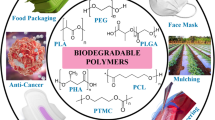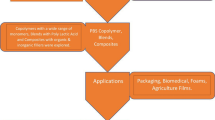Abstract
In this study, firstly, N-(hydroxymethyl) acrylamide (HMAAm) was grafted on poly(ethylene terephthalate) fibers (PET) by utilizing benzoyl peroxide (Bz2O2) as an initiator. The alteration in graft percentage with the polymerization time, temperature, concentration of initiator and monomers were investigated. For grafting experiments, the optimum temperature, duration for grafting and initiator concentration were found be 85 °C, 4 h and 0.008 M, respectively, and the maximum grafting yield was determined to be 25% at these conditions. After grafting, the morphological and chemical changes on the grafted fibers were examined scanning electron microscopy and Fourier-transform infrared spectroscopy. The thermal properties of the obtained PET fibers were examined with differential scanning calorimeter analysis. In addition, the water absorption capacities of the grafted fibers obtained at optimal conditions were investigated and it was found the maximum percentage of water retention reached 56%. Removal of Congo red (CR) with the grafted fibers was performed using a batch process. The effects of different parameters such as pH, grafting yield of HMAAm, adsorption time and CR concentration on the sorption capacity of the grafted fibers were investigated. The optimal pH for adsorption of CR was found to be 2, and the adsorption process reached equilibrium in 4 h. The amount of adsorbed CR molecules increased with the increment in the grafting yield up to 17%, and the graft copolymers adsorbed CR with 5.62 mg/g efficiency when the initial CR concentration was 80 ppm. The PET-g-HMAAm fibers synthesized in this study can be obtained easily and inexpensively, and the constructed fibers could be used to remove ionic substance from aqueous solution.











Similar content being viewed by others
References
Chen H, Zhao J (2009) Adsorption study for removal of Congo red anionic dye using organo-attapulgite. Adsorption 15:381–389. https://doi.org/10.1007/s10450-009-9155-z
Chiou MS, Ho P, Ho Y, Li HY (2004) Adsorption of anionic dyes in acid solutions using chemically cross-linked chitosan beads. Dyes Pigments 60(1):69–84. https://doi.org/10.1016/S0143-7208(03)00140-2
Gong R, Ding Y, Li M, Yang C, Liu H, Sun Y (2005) Utilization of powdered peanut hull as biosorbent for removal of anionic dyes from aqueous solution. Dyes Pigments 64(3):187–192. https://doi.org/10.1016/j.dyepig.2004.05.005
Neamtu M, Yediler A, Siminiceanu I, Macoveanu M, Kellrup A (2004) Decolorization of disperse red 354 azo dye in water by several oxidation processes-a comparative study. Dyes Pigments 60(1):61–68. https://doi.org/10.1016/S0143-7208(03)00129-3
Abdullah AZ, Salamatinia B, Kamaruddin AH (2009) Application of response surface methodology for the optimization of NaOH treatment on oil palm frond towards improvement in the sorption of heavy metals. Desalination 244:227–238. https://doi.org/10.1016/j.desal.2008.06.004
Arslan M, Günay K (2017) Synthesis and characterization of PET fibers grafted with binary mixture of 2-methylpropenoic acid and acrylonitrile by free radical: its application in removal of cationic dye. Polym Bull 74:1221–1236. https://doi.org/10.1007/s00289-016-1773-5
Aboua KN, Yobouet YA, Yao KB, Gona DL, Trokourey A (2015) Investigation of dye adsorption onto activated carbon from the shells of Macore fruit. J Environ Manag 156:10–14. https://doi.org/10.1016/j.jenvman.2015.03.006
Küçükosmanoğlu M, Gezici O, Ayar A (2006) The adsorption behaviors of methylene blue and methyl orange in a diaminoethane sporopollenin-mediated column system. Sep Purif Technol 52:280–287. https://doi.org/10.1016/j.seppur.2006.05.005
Wan Ngah WS, Teong LC, Hanafiah MAKM (2011) Adsorption of dyes and heavy metal ions by chitosan composites: a review. Carbohydr Polym 83:1446–1456. https://doi.org/10.1016/j.carbpol.2010.11.004
Mittal H, Ray SS (2016) A study on the adsorption of methylene blue onto gum ghatti/TiO2 nanoparticles-based hydrogel nanocomposite. Int J Biol Macromol 88:66–80. https://doi.org/10.1016/j.ijbiomac.2016.03.032
Jiang F, Dinh DM, Hsieh YL (2017) Adsorption and desorption of cationic malachite green dye on cellulose nanofibril aerogels. Carbohydr Polym 173:286–294. https://doi.org/10.1016/j.carbpol.2017.05.097
Arslan M, Günay K (2018) Synthesis of amine-functionalized methacrylic acid-g-poly(ethylene terephthalate) fiber and its Congo red removal ability. Polym Bull 75:1701–1713. https://doi.org/10.1007/s00289-017-2121-0
Gün Gök Z, Günay K, Arslan M, Yiğitoğlu M (2019) Removing of congo red from aqueous solution by 2-hydroxyethyl methacrylate-g-poly(ethylene terephthalate) fibers. Polym Bull 76:6179–6191. https://doi.org/10.1007/s00289-019-02721-2
Miluski P, Kochanowicz M, Zmojda J, Dorosz D (2017) Luminescent properties of Tb3+-doped poly(methyl methacrylate) fiber. Chin Opt Lett 15:70602. https://doi.org/10.3788/COL201715.070602
Wang Y, Yin Z, Li H, Gao G, Zhang X (2017) Friction and wear characteristics of ultrahigh molecular weight polyethylene (UHMWPE) composites containing glass fibers and carbon fibers under dry and water-lubricated conditions. Wear 380–381:42–51. https://doi.org/10.1016/j.wear.2017.03.006
Arslan M, Günay K (2019) Application of 4-VP-g-PET fibers and its N-oxide derivative as an adsorbent for removal of cationic dye. Polym Bull 76:963–965. https://doi.org/10.1007/s00289-018-2400-4
Arslan M, Günay K (2018) Synthesis and use of PET fibers grafted with 4-vinyl pyridine and 2-methylpropenoic acid for removal of rhodamine B and methylene blue from aqueous solutions. J Polym Sci Appl 1:3
Arslan M (2011) Immobilization horseradish peroxidase on amine-functionalized glycidyl methacrylate- g-poly(ethylene terephthalate) fibers for use in azo dye decolorization. Polym Bull 66(7):865–879. https://doi.org/10.1007/s00289-010-0316-8
Patel MV, Raval DK, Patel RG, Patel VS (1992) Synthesis, optimization and characterization of graft copolymers from Leucaena glauca seed gum and methylmethacrylate. Carbohydr Polym 17(2):115–120. https://doi.org/10.1016/0144-8617(92)90104-X
Coşkun R, Soykan C, Saçak M (2006) Adsorption of copper (II), nickel (II) and cobalt (II) ions from aqueous solution by methacrylic acid/acrylamide monomer mixture grafted poly (ethylene terephthalate) fiber. Sep Purif Technol 49:107–114. https://doi.org/10.1016/j.seppur.2005.09.002
Dafader NC, Rahman N, Majumdar SK, Khan MMR, Rahman MM (2018) Preparation and characterization of iminodiacetate group containing nonwoven polyethylene fabrics and its application in chromium adsorption. J Polym Environ 26:740–748. https://doi.org/10.1007/s10924-017-0991-8
Yiğitoğlu M, Arslan M (2009) Selective removal of Cr(VI) ions from aqueous solutions including Cr(VI), Cu(II) and Cd(II) ions by 4-vinyl pyridine/2-hydroxyethylmethacrylate monomer mixture grafted poly(ethylene terephthalate) fiber. J Hazard Mater 166(1):435–444. https://doi.org/10.1016/j.jhazmat.2008.11.075
Temoçin Z, Yiğitoğlu M (2009) Studies on selective uptake behavior of Hg(II) and Pb(II) by functionalized poly(ethylene terephthalate) fiber with 4-vinyl pyridine/2-hydroxyethylmethacrylate. Water Air Soil Pollut 210:463–472. https://doi.org/10.1007/s11270-009-0271-x
Monier M, Abdel-Latif DA (2013) Modification and characterization of PET fibers for fast removal of Hg(II), Cu(II) and Co(II) metal ions from aqueous solutions. J Hazard Mater 250–251:122–130. https://doi.org/10.1016/j.jhazmat.2013.01.056
Arslan M (2010) Kinetics of graft copolymerization of acrylamide and 2-hydroxyethylmethacrylate monomer mixture onto poly(ethylene terephthalate) fibers. Korean J Chem Eng 27(3):991–998. https://doi.org/10.1007/s11814-010-0125-7
Temoçin Z, Yiǧitoǧlu M (2009) Studies on the activity and stability of immobilized horseradish peroxidase on poly(ethylene terephthalate) grafted acrylamide fiber. Bioprocess Biosyst Eng 32:467–474. https://doi.org/10.1007/s00449-008-0266-9
Chen KS, Ku YA, Lin HR, Yan TR, Sheu DC, Chen TM (2006) Surface grafting polymerization of N-vinyl-2-pyrrolidone onto a poly(ethylene terephthalate) nonwoven by plasma pretreatment and its antibacterial activities. J Appl Polym Sci 100:803–809. https://doi.org/10.1002/app.23111
Hebeish A, Shalaby SE, Bayazeed AM (1978) Graft copolymerization of 2-methyl-5-vinyl pyridine to poly(ethylene terephthalate) fibres using a post-radiation technique. J Appl Polym Sci 22(11):3335–3342. https://doi.org/10.1002/app.1978.070221127
Arslan M, Yigitoglu M, Sanli O, Ünal HI (2003) Kinetics of swelling assisted grafting of 4-vinyl pyridine onto poly(ethylene terephthalate)fibers using a benzoyl peroxide initiator. Polym Bull 51(3):237–244. https://doi.org/10.1007/s00289-003-0212-6
Gün Gök Z, Günay K, Arslan M, Yiğitoğlu M, Vargel İ (2019) Coating of modified poly(ethylene terephthalate) fibers with sericin-capped silver nanoparticles for antimicrobial application. Polym Bull. https://doi.org/10.1007/s00289-019-02820-0
Shi L, Liu Y, Wang L (2010) solvent effects in the polyethylene terephthalate surface modification by cold argon plasma-induced grafting polymerization of methacrylic acid. J Appl Polym Sci 117:1460–1468. https://doi.org/10.1002/app.32018
Rahman N, Dafader NC, Shakhawat Hossen M, Alam MF, Kabir M, Rakibul Hasan M (2016) Gamma ray induced grafting of binary monomers (acrylic acid/methyl methacrylate) onto polyethylene (PE) films for heavy metal adsorption. J Mater Environ Sci 7:4096–4104
Author information
Authors and Affiliations
Corresponding author
Additional information
Publisher's Note
Springer Nature remains neutral with regard to jurisdictional claims in published maps and institutional affiliations.
Rights and permissions
About this article
Cite this article
Arslan, M., Günay, K., Gün Gök, Z. et al. Synthesis and characterization of poly(ethylene terephthalate) fibers grafted with N-(hydroxymethyl) acrylamide by free radical: its application in elimination of Congo red. Polym. Bull. 78, 1535–1550 (2021). https://doi.org/10.1007/s00289-020-03168-6
Received:
Revised:
Accepted:
Published:
Issue Date:
DOI: https://doi.org/10.1007/s00289-020-03168-6




